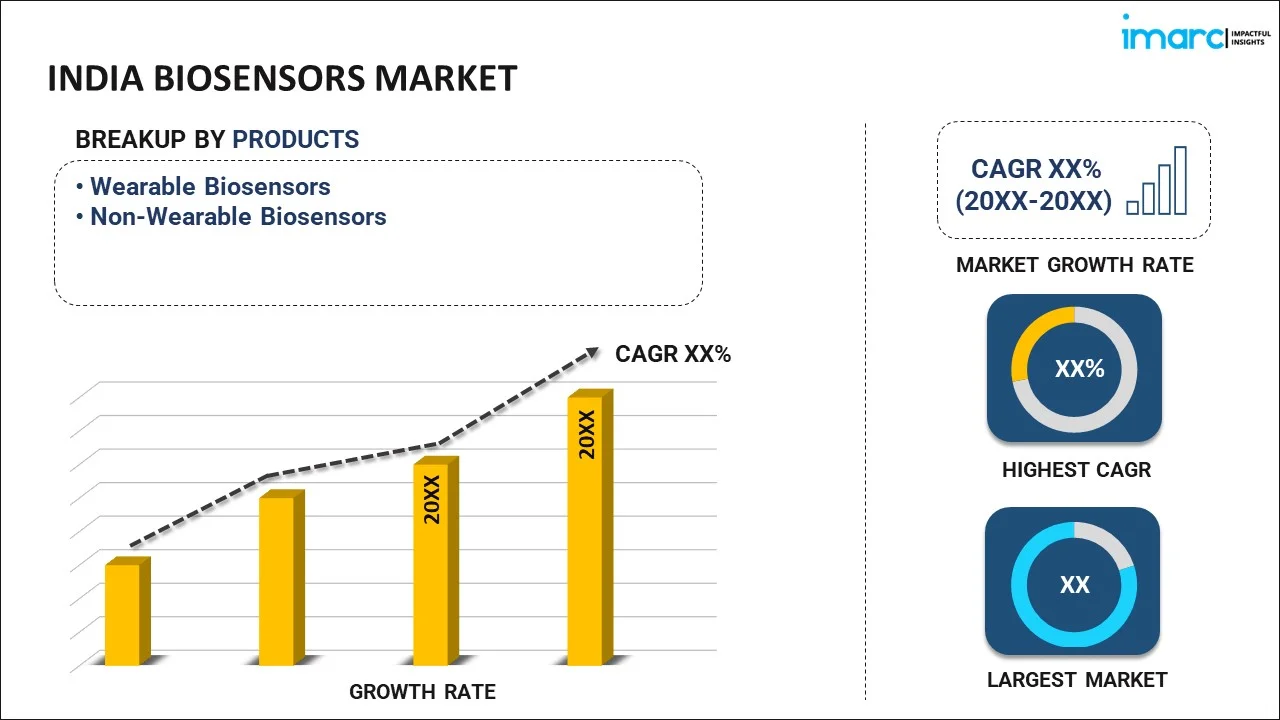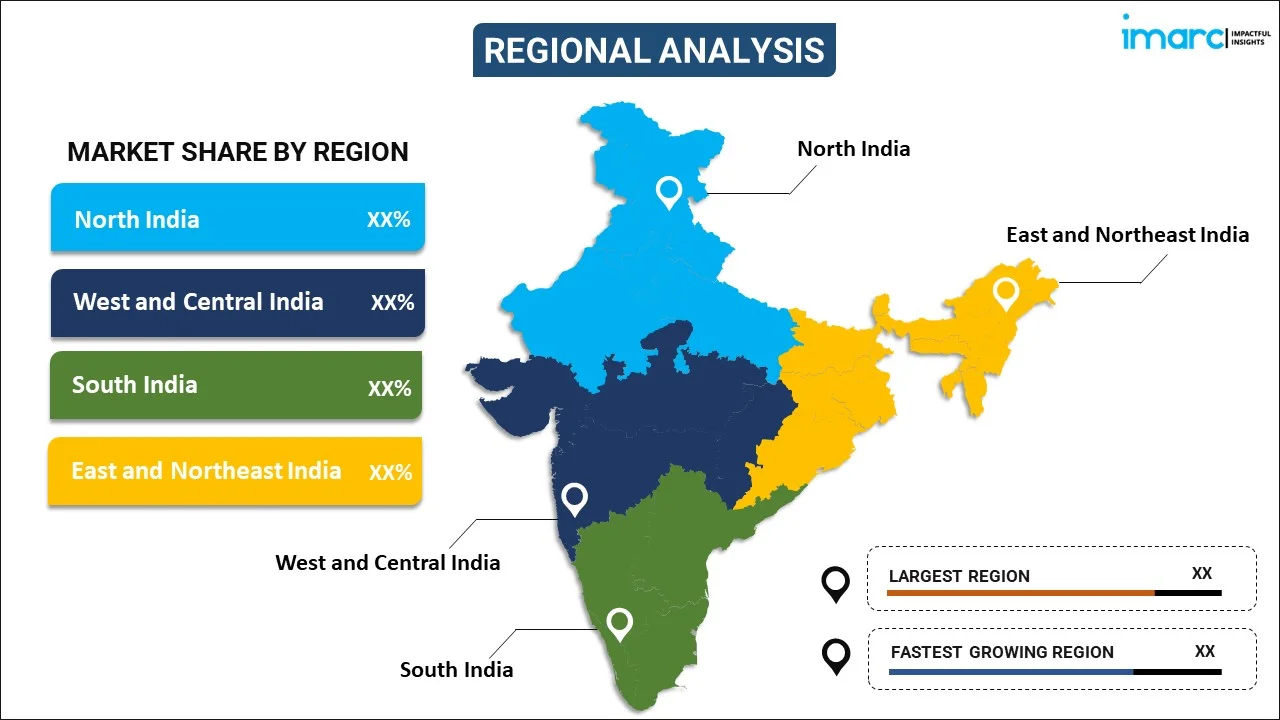
India Biosensors Market Report by Product (Wearable Biosensors, Non-Wearable Biosensors), Technology (Electrochemical Biosensors, Optical Biosensors, Piezoelectric Biosensors, Thermal Biosensors, Nanomechanical Biosensors, and Others), Application (Blood Glucose Testing, Cholesterol Testing, Blood Gas Analysis, Pregnancy Testing, Drug Discovery, Infectious Disease Testing, and Others), End Use (Point of Care Testing, Home Healthcare Diagnostics, Research Laboratories, Security and Biodefense, and Others), and Region 2024-2032
Market Overview:
India biosensors market size is projected to exhibit a growth rate (CAGR) of 9.80% during 2024-2032. The versatility, efficiency, and diverse applications of these instruments position them as critical components in advancing healthcare and scientific endeavors in the country, which is primarily driving the market growth.
|
Report Attribute
|
Key Statistics
|
|---|---|
|
Base Year
|
2023 |
|
Forecast Years
|
2024-2032
|
|
Historical Years
|
2018-2023
|
| Market Growth Rate (2024-2032) | 9.80% |
A biosensor, also known as a biological sensor, is an analytical instrument employed to detect alterations in various biological processes and convert them into an electrical signal. Its primary function is to monitor elements within the biological domain, including enzymes, nucleic acids, tissues, cell receptors, microorganisms, and antibodies. Biosensors encompass various types such as mass, optical, electrochemical, magnetic, nanomechanical, thermometric, acoustic, and immunosensors. Comprising a responsive sensor, transducer, microcontroller, signal conditioning circuit, and display unit, biosensors find applications in resonant mirrors, chemical canaries, optodes, bio-computers, biochips, and glucometers. These devices serve essential roles in point-of-care (POC) diagnostics, research endeavors, environmental monitoring, and applications related to biodefense.
India Biosensors Market Trends:
The biosensors market in India is experiencing notable growth, propelled by advancements in healthcare technology, a surge in research activities, and the increasing application of biosensors in various sectors. One of the key drivers of the biosensors market in India is the expanding use of these devices in point-of-care (POC) diagnostics. Moreover, the growing emphasis on personalized medicine and the need for quick and on-the-spot diagnostics further fuel the demand for biosensors in the country. In the research domain, biosensors are integral tools for studying biological elements such as enzymes, nucleic acids, and antibodies. Besides this, the versatility of biosensors, including mass, optical, electrochemical, and immunosensors, makes them indispensable for various scientific investigations. Additionally, the increasing focus on environmental monitoring aligns with the capabilities of biosensors to detect and analyze pollutants and contaminants. In healthcare applications, biosensors are embedded in devices like glucometers, facilitating real-time monitoring of glucose levels for patients with diabetes. Furthermore, the market also witnesses the integration of biosensors in bio-computers, biochips, resonant mirrors, and other advanced technologies. As India continues to invest in healthcare infrastructure and research capabilities, the biosensors market is poised for sustained growth in the coming years.
India Biosensors Market Segmentation:
IMARC Group provides an analysis of the key trends in each segment of the market, along with forecasts at the country level for 2024-2032. Our report has categorized the market based on product, technology, application, and end use.
Product Insights:

- Wearable Biosensors
- Non-Wearable Biosensors
The report has provided a detailed breakup and analysis of the market based on the product. This includes wearable biosensors and non-wearable biosensors.
Technology Insights:
- Electrochemical Biosensors
- Optical Biosensors
- Piezoelectric Biosensors
- Thermal Biosensors
- Nanomechanical Biosensors
- Others
A detailed breakup and analysis of the market based on the technology have also been provided in the report. This includes electrochemical biosensors, optical biosensors, piezoelectric biosensors, thermal biosensors, nanomechanical biosensors, and others.
Application Insights:
- Blood Glucose Testing
- Cholesterol Testing
- Blood Gas Analysis
- Pregnancy Testing
- Drug Discovery
- Infectious Disease Testing
- Others
The report has provided a detailed breakup and analysis of the market based on the application. This includes blood glucose testing, cholesterol testing, blood gas analysis, pregnancy testing, drug discovery, infectious disease testing, and others.
End Use Insights:
- Point of Care Testing
- Home Healthcare Diagnostics
- Research Laboratories
- Security and Biodefense
- Others
A detailed breakup and analysis of the market based on the end use have also been provided in the report. This includes point of care testing, home healthcare diagnostics, research laboratories, security and biodefense, and others.
Regional Insights:

- North India
- West and Central India
- South India
- East and Northeast India
The report has also provided a comprehensive analysis of all the major regional markets, which include North India, West and Central India, South India, and East and Northeast India.
Competitive Landscape:
The market research report has also provided a comprehensive analysis of the competitive landscape. Competitive analysis such as market structure, key player positioning, top winning strategies, competitive dashboard, and company evaluation quadrant has been covered in the report. Also, detailed profiles of all major companies have been provided.
India Biosensors Market Report Coverage:
| Report Features | Details |
|---|---|
| Base Year of the Analysis | 2023 |
| Historical Period | 2018-2023 |
| Forecast Period | 2024-2032 |
| Units | US$ Million |
| Scope of the Report | Exploration of Historical Trends and Market Outlook, Industry Catalysts and Challenges, Segment-Wise Historical and Future Market Assessment:
|
| Products Covered | Wearable Biosensors, Non-Wearable Biosensors |
| Technologies Covered | Electrochemical Biosensors, Optical Biosensors, Piezoelectric Biosensors, Thermal Biosensors, Nanomechanical Biosensors, Others |
| Applications Covered | Blood Glucose Testing, Cholesterol Testing, Blood Gas Analysis, Pregnancy Testing, Drug Discovery, Infectious Disease Testing, Others |
| End Uses Covered | Point of Care Testing, Home Healthcare Diagnostics, Research Laboratories, Security and Biodefense, Others |
| Regions Covered | North India, West and Central India, South India, East and Northeast India |
| Customization Scope | 10% Free Customization |
| Report Price and Purchase Option | Single User License: US$ 2699 Five User License: US$ 3699 Corporate User License: US$ 4699 |
| Post-Sale Analyst Support | 10-12 Weeks |
| Delivery Format | PDF and Excel through Email (We can also provide the editable version of the report in PPT/Word format on special request) |
Key Questions Answered in This Report:
- How has the India biosensors market performed so far and how will it perform in the coming years?
- What has been the impact of COVID-19 on the India biosensors market?
- What is the breakup of the India biosensors market on the basis of product?
- What is the breakup of the India biosensors market on the basis of technology?
- What is the breakup of the India biosensors market on the basis of application?
- What is the breakup of the India biosensors market on the basis of end use?
- What are the various stages in the value chain of the India biosensors market?
- What are the key driving factors and challenges in the India biosensors?
- What is the structure of the India biosensors market and who are the key players?
- What is the degree of competition in the India biosensors market?
Key Benefits for Stakeholders:
- IMARC’s industry report offers a comprehensive quantitative analysis of various market segments, historical and current market trends, market forecasts, and dynamics of the India biosensors market from 2018-2032.
- The research report provides the latest information on the market drivers, challenges, and opportunities in the India biosensors market.
- Porter's five forces analysis assist stakeholders in assessing the impact of new entrants, competitive rivalry, supplier power, buyer power, and the threat of substitution. It helps stakeholders to analyze the level of competition within the India biosensors industry and its attractiveness.
- Competitive landscape allows stakeholders to understand their competitive environment and provides an insight into the current positions of key players in the market.
Need more help?
- Speak to our experienced analysts for insights on the current market scenarios.
- Include additional segments and countries to customize the report as per your requirement.
- Gain an unparalleled competitive advantage in your domain by understanding how to utilize the report and positively impacting your operations and revenue.
- For further assistance, please connect with our analysts.
 Inquire Before Buying
Inquire Before Buying
 Speak to an Analyst
Speak to an Analyst
 Request Brochure
Request Brochure
 Request Customization
Request Customization




.webp)




.webp)












